
| Optical Spectroscopy and Molecular Physics |
| Prof. Dr. C. von Borczyskowski |
Faculty of Natural Sciences
Institut of Physics
 « back ] |
[ print »
« back ] |
[ print » 
 |
|
Chemnitz University of Technology
Faculty of Natural Sciences Institut of Physics |
||
 « back ] |
[ print » « back ] |
[ print »  |
||||
| 26.04.2024 | ||||
| Welcome to our Homepage | The OSMP Group |
|
|
Influence of the Glass Transition on Rotational Dynamics of Dyes in Thin Polymer Films. Single Molecule and Ensemble Experiments
B. Aráoz, A. Carattino, D. Täuber, C. von Borczyskowski and P.F. Aramendía, J. Phys. Chem. A, DOI: 10.1021/jp500272y We performed polarized fluorescence emission studies of Nile Red (NR) in poly(methyl methacrylate) (PMMA), poly(ethyl methacrylate) (PEMA), and poly(butyl methacrylate) (PBMA) at the single molecule (SM) and at the ensemble level to study the in cage movements of the ground-state molecule in polymer films of nanometric thickness at room temperature. Experiments were performed with wide field irradiation. At the ensemble level, the linearly polarized irradiation was used to induce a photoselection by bleaching, which is compensated by rotational diffusion. Both results show an appreciable difference in mobility of NR in the films that is correlated with the different glass-transition temperatures of the films, particularly in PEMA, which displays a clearly distinct behavior between the 200 nm films, representing a rigid environment, and the 25 nm ones, showing much higher mobility. We developed a model of broad application for polarized photobleaching that allows obtaining rotational diffusion coefficients and photobleaching quantum yields in an easy way from ensemble experiments. The parameters obtained from ensemble measurements correlate well with the results from SM experiments. ( |
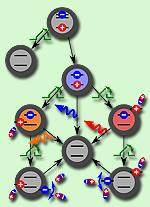
|
The Fluorescence Intermittency for Quantum Dots is Not Power-Law Distributed: a Luminescence Intensity Resolved Approach
R. Schmidt, C. Krasselt, C. Göhler, and C. von Borczyskowski ACS Nano, 2014 The photoluminescence (PL) of single emitters like semiconductor quantum dots (QDs) shows PL intermittency, often called blinking. We explore the PL intensities of single CdSe/ZnS QDs in polystyrene (PS), on polyvenylalcohol (PVA) and on silicon oxide (SiOx) by the “change-point analysis” (CPA). By this, we relate results from the macro-time (sub-ms to 1000 s) and the micro-time (0.1 100 ns) range to discrete PL intensities. We conclude that the intensity selected “on”-times in the ms range correspond to only a few (discrete) switching times while the PL decays in the ns range are multi-exponential even with respect to the same selected PL intensity. Both types of relaxation processes depend systematically on the PL intensity in course of a blinking time trace. The overall distribution of “on”-times does not follow a power law contrary to what has often been reported but can be compiled into 3-4 characteristic “on”-times. The results can be explained by the recently suggested multiple-recombination centres model. Additionally, we can identify a well defined QD state with a very low PL intensity above the noise level which we assign to the strongly quenched exciton state. We describe our findings by a model of a hierarchical sequence of hole and electron trapping. Blinking events are the consequence of slow switching processes among these states and depend on the physico-chemical properties of the heterogeneous nano-interface of the QDs. ( |
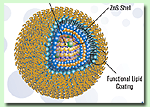
|
Formation Principles and Exciton Relaxation in SemiconductorQuantum Dot-Dye Nanoassemblies
C. von Borczyskowski, E. Zenkevich in Quantum Dot Molecules, Lecture Notes in Nanoscale Science and Technology, p. 77-148 (Ed.:J. Wu, Z. M. Wang), Springer, New York Heidelberg Dordrecht London, 2014 In this chapter we discuss "bottom-up" non-covalent self-assembly principles which define a strategy for the formation of organic-inorganic nanoassemblies containing colloidal semiconductor quantum dots (QD) of different types (based on a CdSe core) and various heterocyclic molecules (dyes) with functionalized anchoring side substituents (meso-pyridyl substituted porphyrins and perylene diimides). Using a combination of ensemble and single molecule spectroscopy of "QD-Dye" nanoassemblies, we show that single functionalized molecules can be considered as extremely sensitive probes for studying the complex interface physics and chemistry (influence of the embedding environment and temperature) and related exciton relaxation processes in QDs. It will been quantitatively laid out that the major part of the observed QD photoluminescence (PL) quenching in nanoassemblies can be understood on one hand in terms of exciton wave function tunneling under the condition of quantum confinement and on the other hand by the influence of ligand dynamics. In nanoassemblies, photoinduced Foerster-type energy transport (FRET) QD Dye is often only a small contribution to the PL quenching and is effectively suppressed already in slightly polar solvents which is often overlooked in literature. Finally we like to point out, that properties of "QD-Dye" nanoassemblies are not only interesting in themselves, but also provide a valuable tool to study surface related phenomena in QDs on an extremely low level of surface modification thus providing the data for a further development of defined multicomponent structures for exploitation as artificial light-harvesting complexes, electro- and photochemical devices or nanosensors. ( |
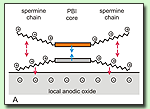
|
Functional bisimide dyes bound via electrostatic interactions to oxide nanostructures generated by AFM lithography
T. Baumgärtel, S. Rehm, F. Würthner, C. von Borczyskowski, and H. Graaf Appl. Surf. Sci., DOI10.1016/j.apsusc.2013.12.094 2014 Silicon oxide nanostructures have been functionalized by selective binding of a positively charged bisimide dye derivative. The structures were prepared by AFM nanolithography via local anodic oxidation (LAO) of dodecyl-terminated silicon and are negatively charged due to the production process. Therefore cationic spermine-functionalized perylene bisimide (sf-PBI) molecules can be bound to the structures by electrostatic interactions. The assembly of the sf-PBI units on the LAO nanostructures is verified by AFM height measurements and means of fluorescence microscopy. Emission spectra from the dye-functionalized oxide show that the molecules are able to form excimers. These excimers are characterized by a broad and featureless red-shifted emission band and an increased excited state life time. In contrast to the emission of sf-PBI films on uncharged silicon oxide, the excimer emission was found to decrease strongly for low temperatures. This may be explained by a very tight binding due to the electrostatic attraction of the molecules to the LAO oxide. ( |
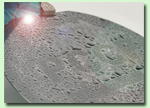
|
Inkjet Printing as a Tool for the Patterned Deposition of Octadecylsiloxane Monolayers on Silicon Oxide Surfaces
C. Belgardt, E. Sowade, T. Blaudeck, T. Baumgärtel, H. Graaf, C. von Borczyskowski, and R. R. Baumann Phys. Chem. Chem. Phys., 15, 157494-157504, 2013 We present a case study about inkjet printing as a tool for molecular patterning of silicon oxide surfaces with hydrophobic functionality, mediated by n-octadecyltrichlorosilane (OTS) molecules. In contrast to state-of-the-art techniques such as micro contact printing or chemical immersion with subsequent lithography processes, piezo drop-on-demand inkjet printing does not depend on physical masters, which allows an effective direct-write patterning of rigid or flexible substrates and enables short run-lengths of the individual pattern. In this paper, we used mesithylene-based OTS inks, jetted them in droplets of 10 pL on a silicon oxide surface, evaluated the water contact angle of the patterned areas and fitted the results with Cassie's law. For inks of 2.0 mM OTS concentration, we found that effective area coverages of 38% can be obtained. Our results hence show that contact times of the order of hundred milliseconds are sufficient to form a pattern of regions with OTS molecules adsorbed to the surface, representing at least a fragmented, inhomogeneous self-assembled OTS monolayer (OTS-SAM). ( |

|
Optical Tracking of Single Ag Clusters in Nanostructured Water Films
S. Krause, M. Hartmann, I. Kahle, M. Neuman, M. Heidernätsch, S. Spange, and C. von Borczyskowski J. Phys. Chem. C, 117(-), 24822-24829, 2013 The spatial diffusion and size distribution of monodisperse silver nanoclusters synthesized via Ag (I) carboxylate in zeolite Y cages is investigated in nanostructured water films on silicon dioxide (SiO2) and mica surfaces with optical and atomic force techniques. Subnanometer clusters escaping the zeolite Y cage show a strong and photostable fluorescence emission in the visible range and allow for optical single cluster tracking. Heterogeneous diffusion dynamics reflect the transition from an ice-like to a liquid-like water film as a function of film thickness. The contributions of the different diffusion coefficients strongly correlate with the water film thickness and the chemical composition of the interface. The heterogeneity of the diffusion is caused by ad- and desorption of Ag clusters to silanol groups at the SiO2 interface which couple vibronically to the Ag clusters as can be seen from single cluster fluorescence spectra. ( |
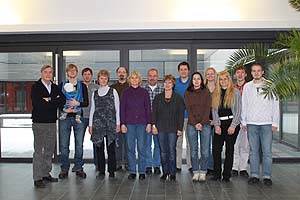
|
The OSMP Group
our group in the |
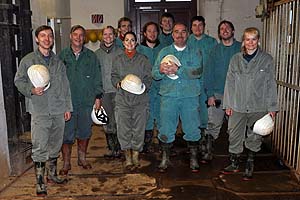
|
A part at the OSMP Group in December 2012 |

| - Centre for Nanostructured Materials and Analytics - |

| - SFG "From Local Constraints to Macroscopic Transport" - |
| (©) L. Feige, 04/2024 (OSMP) | [ Imprint ] |